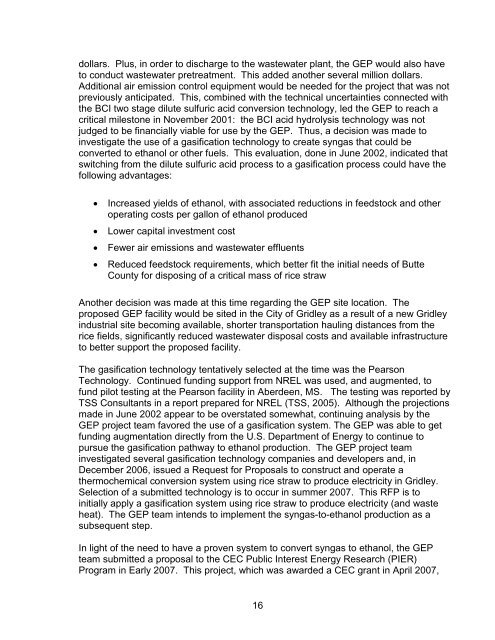Assessment of Conversion Technologies for Bioalcohol Fuel ...
Assessment of Conversion Technologies for Bioalcohol Fuel ...
Assessment of Conversion Technologies for Bioalcohol Fuel ...
You also want an ePaper? Increase the reach of your titles
YUMPU automatically turns print PDFs into web optimized ePapers that Google loves.
dollars. Plus, in order to discharge to the wastewater plant, the GEP would also have<br />
to conduct wastewater pretreatment. This added another several million dollars.<br />
Additional air emission control equipment would be needed <strong>for</strong> the project that was not<br />
previously anticipated. This, combined with the technical uncertainties connected with<br />
the BCI two stage dilute sulfuric acid conversion technology, led the GEP to reach a<br />
critical milestone in November 2001: the BCI acid hydrolysis technology was not<br />
judged to be financially viable <strong>for</strong> use by the GEP. Thus, a decision was made to<br />
investigate the use <strong>of</strong> a gasification technology to create syngas that could be<br />
converted to ethanol or other fuels. This evaluation, done in June 2002, indicated that<br />
switching from the dilute sulfuric acid process to a gasification process could have the<br />
following advantages:<br />
Increased yields <strong>of</strong> ethanol, with associated reductions in feedstock and other<br />
operating costs per gallon <strong>of</strong> ethanol produced<br />
Lower capital investment cost<br />
Fewer air emissions and wastewater effluents<br />
Reduced feedstock requirements, which better fit the initial needs <strong>of</strong> Butte<br />
County <strong>for</strong> disposing <strong>of</strong> a critical mass <strong>of</strong> rice straw<br />
Another decision was made at this time regarding the GEP site location. The<br />
proposed GEP facility would be sited in the City <strong>of</strong> Gridley as a result <strong>of</strong> a new Gridley<br />
industrial site becoming available, shorter transportation hauling distances from the<br />
rice fields, significantly reduced wastewater disposal costs and available infrastructure<br />
to better support the proposed facility.<br />
The gasification technology tentatively selected at the time was the Pearson<br />
Technology. Continued funding support from NREL was used, and augmented, to<br />
fund pilot testing at the Pearson facility in Aberdeen, MS. The testing was reported by<br />
TSS Consultants in a report prepared <strong>for</strong> NREL (TSS, 2005). Although the projections<br />
made in June 2002 appear to be overstated somewhat, continuing analysis by the<br />
GEP project team favored the use <strong>of</strong> a gasification system. The GEP was able to get<br />
funding augmentation directly from the U.S. Department <strong>of</strong> Energy to continue to<br />
pursue the gasification pathway to ethanol production. The GEP project team<br />
investigated several gasification technology companies and developers and, in<br />
December 2006, issued a Request <strong>for</strong> Proposals to construct and operate a<br />
thermochemical conversion system using rice straw to produce electricity in Gridley.<br />
Selection <strong>of</strong> a submitted technology is to occur in summer 2007. This RFP is to<br />
initially apply a gasification system using rice straw to produce electricity (and waste<br />
heat). The GEP team intends to implement the syngas-to-ethanol production as a<br />
subsequent step.<br />
In light <strong>of</strong> the need to have a proven system to convert syngas to ethanol, the GEP<br />
team submitted a proposal to the CEC Public Interest Energy Research (PIER)<br />
Program in Early 2007. This project, which was awarded a CEC grant in April 2007,<br />
16
















